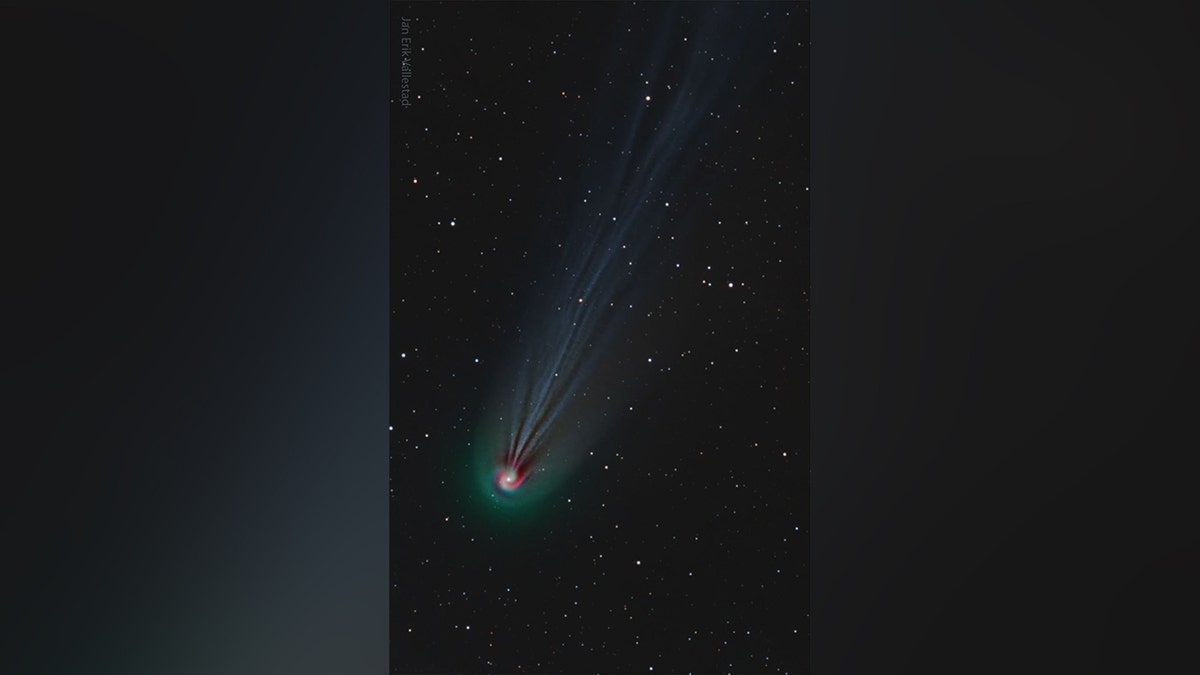While the total solar eclipse was the celestial focus in April 2024, the “Devil Comet” also received attention from skywatchers.
Known officially and scientifically as Comet 12P/Pons-Brooks, the rare comet, with its moniker suggestive of a fall from grace, neared Earth for the first time in 71 years.
What makes this comet particularly unique is the “horned” appearance of the astronomical object.
MOON LANDING 55 YEARS AGO TOPS LIST OF 7 POWERFUL EXAMPLES OF AMERICAN EXCEPTIONALISM
Here’s a deeper dive.
Comets, often called “cosmic snowballs” by NASA, are composed of dust, rock and ice. Comets orbit the sun in a highly elliptical orbit, spending years at the depths of the solar system and then returning to the sun.
They range in size and can be as small as a few miles across, but their nuclei generally do not exceed 6 miles in width.
COMET SWIFT-TUTTLE: WHAT TO KNOW
While the solid core of a comet, known as its nucleus, remains relatively unchanged, the size of its outer envelope, or coma, can dramatically increase as it nears the sun.
The heat causes ice to sublimate into gas, releasing dust and expanding the coma to sizes that exceed the largest planets in volume, although not in mass or density.

The Devil Comet, formally known as Comet 12P/Pons-Brooks, orbits the sun every 71 years. (Jan Erik Vallestad via nasa.gov)
Comet 12P/Pons-Brooks is recognized for its relatively bright appearance when it nears Earth. Its orbit brings it into proximity with our planet approximately every 71 years, which is the periodic visitation of the comet, according to NASA.
The Devil Comet is similar to Halley’s Comet because they are both short-period comets, a characterization based on their regular return to the inner solar system.
Pons-Brooks was spotted for the first time in 1812 by comet hunter Jean-Louis Pons. His observations, however, did not predict when or where the comet would return. In 1883, William Brooks noticed the comet for the second time.
SCIENTISTS DISCOVER MASSIVE CAVE ON MOON THAT COULD BE USED TO SHELTER ASTRONAUT
Comet 12P/Pons-Brooks, like other comets, is primarily composed of ice, dust and rock.
As it is also identified as cryovolcanic, it acts as a type of volcano. Instead of erupting molten rock, however, it erupts water, ammonia or methane.
In July 2023, Comet 12P/Pons-Brooks was nicknamed “Devil Comet” due to an outburst that showed an asymmetrical structure and horn-like features.
The outburst, causing the release of ice and gas, caused the comet to brighten – by about 100 times its usual level.

12P/PonsBrooks Comet is one of the brightest known comets. In 2023, a gas and dust outburst caused it to have horns, which resulted in the nickname “Devil Comet.” (Lorenzo Di Cola/NurPhoto via Getty Images)
Astronomers, while uncertain about the exact cause of the horn-like structures, propose that they might result from an uneven ejection of gas and dust.
Another theory is the possibility of a shadow effect when observed from Earth.
CLICK HERE TO SIGN UP FOR OUR LIFESTYLE NEWSLETTER
Following the outburst, the comet appeared normal again but later displayed the horns that gave it its nickname due to a similar distortion.
NASA PREPARES FOR INTERNATIONAL SPACE STATION RETIREMENT
The other name for the comet is “Mother of Dragons” because of its association with the kappa-Draconids meteor shower, which is active between November and December every year.
The comet was viewable from the Northern Hemisphere in spring 2024, around the time of the solar eclipse.
The comet was best seen with binoculars or a small telescope after the sun lowered itself below the horizon, according to Space Daily.
As of July, the comet was not bright enough to be viewed, even with these tools.

The comet does not pose any danger to Earth because it won’t ever cross Earth’s orbit. (Marcos del Mazo/LightRocket via Getty Images)
12P/Pons-Brooks reached its peak visibility on Sunday, April 21, 2024, its brightest appearance from Earth in 71 years.
At this time, the comet reached perihelion, the point within its orbit when it is closest to the sun, according to Samantha Mathewson of Space.com.
Despite the ominous nickname given to Pons-Brooks, it does not threaten Earth. The comet’s orbit brings it close, but not across Earth’s path.
CLICK HERE TO GET THE FOX NEWS APP
Because of the inclined trajectory of the comet, it weaves between the orbits of Earth and Venus before it leaves the inner solar system, according to an article on astronomy.com.
